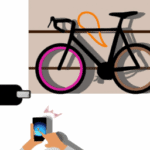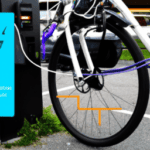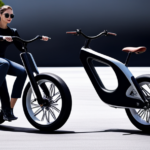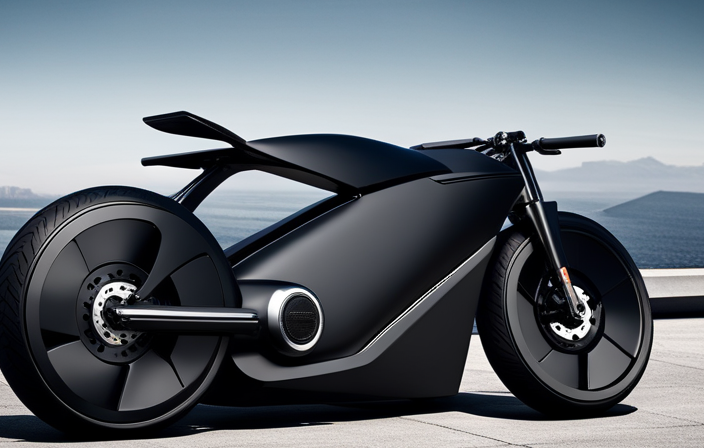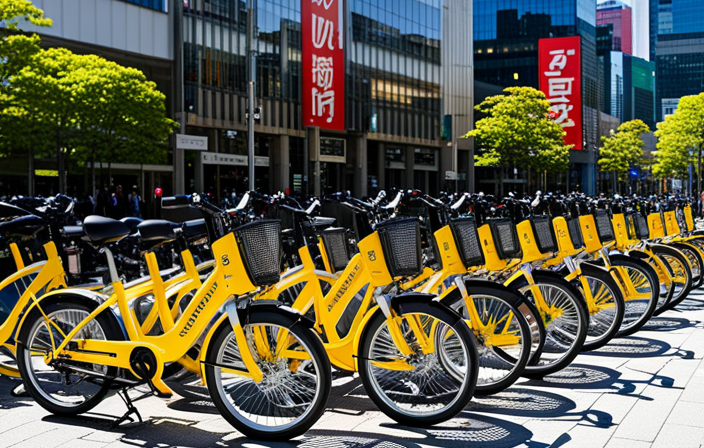Are you tired of constantly running out of battery power on your electric bike? Well, get ready to say goodbye to those days, because I’m about to reveal the ultimate charging strategy that will blow your mind!
In this article, I will guide you through the intricacies of charging an electric bike and help you determine exactly how much juice you need to keep those wheels spinning.
Get ready to ride with confidence and never worry about a dead battery again!
Key Takeaways
- Charging an electric bike depends on its battery capacity, which is measured in watt-hours (Wh).
- It is important to optimize battery performance by understanding the factors that affect it, such as terrain, rider weight, assist level, wind resistance, and temperature.
- Considering these factors is crucial for efficient planning and determining the distance that can be covered on a single charge.
- Riding style and weight also have an impact on battery consumption, with aggressive riding and heavier riders requiring more power.
Understanding the Battery Capacity of Your Electric Bike
Understanding the battery capacity of your electric bike is crucial for determining how far you can ride on a single charge. The battery capacity is typically measured in watt-hours (Wh), which indicates the amount of energy the battery can store.
Calculating battery efficiency is essential in optimizing battery performance. To calculate battery efficiency, divide the battery’s capacity by the power consumption of your electric bike. This will give you an estimate of how many miles you can ride before the battery needs to be recharged.
Optimizing battery performance involves factors such as riding at a consistent speed, avoiding excessive acceleration or braking, and keeping the battery at a moderate temperature.
By understanding the battery capacity and optimizing its performance, you can maximize the range of your electric bike and enjoy longer rides without worrying about running out of power.
Calculating the Range of Your Electric Bike
To calculate the range of your e-bike, you can determine the distance it can travel on a single battery charge. The battery range refers to the maximum distance your electric bike can cover before the battery needs to be recharged. It is an important factor to consider when planning your rides and managing battery life expectancy.
Here are five key factors that can affect your e-bike’s battery range:
-
Terrain: The type of terrain you ride on, such as flat roads or hilly terrains, can impact your battery range.
-
Rider weight: Heavier riders may experience a slightly shorter battery range compared to lighter riders.
-
Assist level: Using a higher assist level will consume more battery power and decrease the range.
-
Wind resistance: Riding against strong headwinds can increase the energy consumption and reduce the battery range.
-
Temperature: Extreme hot or cold temperatures can affect the battery performance, resulting in a shorter range.
Understanding these factors that affect battery consumption will help you plan your rides more efficiently.
Factors that Affect Battery Consumption
Factors that affect battery consumption include terrain, rider weight, assist level, wind resistance, and temperature. These factors play a crucial role in determining how long your electric bike’s battery will last before needing to be recharged.
Battery performance is dependent on the type of battery technology used in your electric bike. Lithium-ion batteries, for example, are known for their high energy density and long lifespan, making them a popular choice for electric bikes. However, regardless of the battery technology, riding uphill or on rough terrains will consume more battery power compared to riding on flat surfaces. Elevation changes also impact battery consumption as the motor has to work harder to maintain speed.
Understanding these factors will help you optimize your electric bike’s battery life and plan your rides accordingly.
Riding Terrain and Elevation
Riding on different terrains and dealing with changes in elevation can significantly impact the performance of your e-bike’s battery. When it comes to riding techniques, it is important to consider how you tackle uphill and downhill sections.
Uphill riding requires more power from the battery, as the motor has to work harder to overcome the resistance. On the other hand, downhill sections provide an opportunity for the battery to recharge through regenerative braking, where the motor acts as a generator and converts kinetic energy into electrical energy.
Additionally, riding on hilly terrains with frequent changes in elevation can cause the battery to drain faster, as the motor constantly needs to adjust its power output. These factors should be taken into account when planning your rides to ensure optimal battery life.
Transitioning into the next section about riding speed and style, it is essential to understand how these factors can further impact battery consumption.
Riding Speed and Style
When you ride faster and more aggressively, you’ll notice a significant decrease in your e-bike’s battery life. This is because riding at higher speeds requires more power from the motor, which in turn drains the battery more quickly.
Additionally, riding in a more aggressive manner, such as accelerating quickly or climbing steep hills at a fast pace, puts additional strain on the motor and battery.
To maximize the battery life of your electric bike, it is important to practice efficient riding techniques. This includes maintaining a steady speed, avoiding sudden acceleration or braking, and using the appropriate gear for the terrain. By doing so, you can extend the range of your electric bike and minimize the need for frequent recharging.
Speaking of efficiency, let’s now discuss how the weight of the rider and cargo can affect the battery life.
Weight of the Rider and Cargo
To maximize your e-bike’s battery life, it’s important to consider the impact of your weight and the weight of any cargo you may be carrying. The combined weight of the rider and cargo affects the bike’s performance and efficiency. Here are three key factors to keep in mind:
-
Rider weight: Heavier riders require more power from the motor to maintain the same speed, which can drain the battery faster. It’s essential to choose an e-bike with a motor and battery capacity suitable for your weight.
-
Cargo weight: Carrying additional cargo adds extra load to the bike, which can decrease its range and speed. Be mindful of the weight you are carrying and try to distribute it evenly for better balance and stability.
-
Hill climbing ability: Both rider and cargo weight impact the e-bike’s ability to climb hills. Heavier loads may require more assistance from the motor, leading to increased battery consumption.
Considering cargo weight and rider weight is crucial in determining the appropriate charging requirements for your e-bike.
When it comes to weather conditions…
Weather Conditions
As we discussed earlier, the weight of the rider and cargo can affect the performance and battery life of an electric bike. However, another factor that can significantly impact an electric bike’s maintenance and battery life is the weather conditions. Extreme temperatures, whether it’s scorching hot or freezing cold, can have a detrimental effect on the battery’s performance and overall lifespan. High temperatures can cause the battery to overheat and degrade faster, while freezing temperatures can reduce its capacity and power output. To help you understand the impact of weather conditions on an electric bike’s battery, here is a table highlighting the effects of temperature on battery life:
| Temperature Range | Impact on Battery Life |
|---|---|
| Hot (above 95°F) | Decreased lifespan, reduced performance |
| Cold (below 32°F) | Reduced capacity, lower power output |
Now that we understand the impact of weather conditions on an electric bike, let’s explore some charging techniques for maximizing battery life.
Charging Techniques for Maximizing Battery Life
One way you can maximize the lifespan of your battery is by using proper charging techniques. By applying these techniques, you can not only maximize efficiency but also reduce charging time.
First, it is essential to follow the manufacturer’s guidelines for charging. This includes using the recommended charger and avoiding using third-party chargers that may not be compatible with your electric bike.
Additionally, it is advisable to avoid charging your battery to its full capacity every time. Instead, aim to keep the battery level between 20% and 80% for optimal performance and longevity.
Furthermore, try to avoid frequent partial charges, as they can reduce the battery’s overall capacity.
By employing these charging techniques, you can ensure that your electric bike’s battery lasts longer and performs at its best.
It is crucial to note that overcharging can have detrimental effects on your battery’s lifespan, so it is vital to avoid excessive charging.
Avoid Overcharging
Make sure you don’t overcharge your battery to maximize its lifespan. When it comes to charging an electric bike, following charging best practices is crucial. Overcharging can lead to decreased battery performance and even shorten its lifespan. To avoid this, it’s important to understand common charging mistakes and how to prevent them.
To illustrate this, let’s take a look at a table that showcases the emotions associated with overcharging and taking proper care of your battery:
| Overcharging | Proper Care |
|---|---|
| Anxiety | Peace of mind |
| Frustration | Confidence |
| Disappointment | Longevity |
| Regret | Efficiency |
| Unreliability | Dependability |
By following these charging best practices and avoiding common charging mistakes, you can ensure that your battery remains in optimal condition. Now, let’s move on to the next section about charging at moderate temperatures.
Charge at Moderate Temperatures
When it comes to charging your electric bike, it’s important to avoid overcharging to ensure the longevity of your battery. But that’s not the only consideration you should keep in mind.
Another crucial factor is the temperature at which you charge your bike. Charging it at moderate temperatures can have a significant impact on maximizing efficiency and extending the lifespan of your battery. Extreme temperatures, whether hot or cold, can negatively affect the performance and overall health of your battery.
To determine the optimal charging time for your electric bike, it’s advisable to consult the manufacturer’s recommendations. Following their guidelines will help you get the most out of your battery and ensure a longer riding experience.
Now, let’s move on to the next important step: using the right charger.
Use the Right Charger
Using the correct charger for your e-bike is essential for optimal performance and battery longevity. Maximizing efficiency and prolonging the lifespan of your electric bike’s battery greatly depend on using the right charger. Different chargers have varying charging speeds and voltages, and using an incompatible charger can lead to damage or slower charging times. To highlight the importance of using the correct charger, consider the following table:
| Charger Type | Charging Speed | Compatibility |
|---|---|---|
| Standard Charger | Average | Compatible with most e-bikes |
| Fast Charger | Faster | Check compatibility with your e-bike manufacturer |
| Portable Charger | Slower | Suitable for emergency charging only |
| Smart Charger | Optimized | Compatible with specific e-bike models and battery types |
By selecting the appropriate charger, you can ensure that your electric bike charges efficiently and safely. This charging habit helps maximize your e-bike’s performance and battery life. Avoiding frequent partial charging is the next step towards maintaining your electric bike’s battery health.
Avoid Frequent Partial Charging
To maintain optimal battery health, it’s important to minimize frequent partial charging. When you constantly charge your electric bike battery without fully depleting it, it can lead to a phenomenon called ‘memory effect.’ This means that the battery ‘remembers’ the smaller capacity and adjusts its charging capacity accordingly. To avoid this, it’s recommended to charge your electric bike battery fully whenever possible. This not only helps prevent the memory effect but also ensures that you get the maximum range out of each charge.
Here are some factors to consider when calculating charging time and understanding the impact of frequent partial charging:
- Battery longevity: Frequent partial charging can decrease the overall lifespan of your battery.
- Range anxiety: Partial charging can limit your electric bike’s range and leave you worried about running out of power during longer rides.
- Efficiency: Frequent partial charging can reduce the overall efficiency of your electric bike.
- Battery capacity: Fully charging your battery helps maintain its maximum capacity.
Understanding the impact of frequent partial charging is crucial for determining the ideal charging frequency and maximizing the lifespan and performance of your electric bike battery.
Determining the Ideal Charging Frequency
Determining the ideal frequency for charging your battery is important for maximizing its lifespan and performance. To maximize efficiency, it is recommended to avoid frequent partial charging. Instead, aim for charging your electric bike battery when it reaches around 20-30% of its capacity. This allows for optimal utilization of the battery’s energy storage capabilities.
Additionally, it is important to optimize charging time by avoiding overcharging. Once the battery reaches 80-90% of its capacity, it is best to unplug the charger to prevent unnecessary strain on the battery cells. By following these guidelines, you can ensure that your battery lasts longer and performs at its best.
Now let’s move on to estimating the cost of charging your electric bike.
Estimating the Cost of Charging Your Electric Bike
You can estimate the cost of charging your e-bike by calculating the electricity consumption based on the battery capacity and the local electricity rate. To do this, follow these steps:
-
Determine the battery capacity of your electric bike. This information can usually be found in the user manual or on the manufacturer’s website.
-
Check the local electricity rate per kilowatt-hour (kWh). This can be found on your electricity bill or by contacting your utility provider.
-
Multiply the battery capacity by the local electricity rate to calculate the cost of charging your e-bike.
By using energy efficient charging methods, such as charging during off-peak hours or using a smart charger that automatically adjusts the charging rate, you can further reduce the cost of charging your electric bike.
Transitioning to the subsequent section about electricity rates, it is important to understand how they can vary depending on your location.
Electricity Rates
When estimating the cost of charging your electric bike, one important factor to consider is the electricity rates in your area. Electricity rates can vary depending on where you live, so it’s essential to understand how much you’ll be paying per kilowatt-hour (kWh).
By comparing the electricity rates of different providers, you can determine which one offers the most cost-effective option for charging your electric bike. Take into account any special rates or time-of-use plans that might be available, as they can significantly impact your overall charging costs.
Additionally, consider the efficiency of your electric bike’s battery and how many kWh it requires for a full charge. This information will help you calculate the exact cost of charging your electric bike and make an informed decision.
Now, let’s delve into the next section and explore the optimal charging time and frequency for your electric bike.
Charging Time and Frequency
To optimize your electric bike’s battery life, it’s important to consider the best times and frequency for charging. Charging efficiency plays a crucial role in maximizing the lifespan of your battery. When it comes to charging time, it is recommended to charge your electric bike when the battery level is between 20% and 80% to ensure the longest possible lifespan. Overcharging or frequently charging to 100% can degrade the battery faster. Additionally, charging at a slower rate, such as using a lower amperage charger, can also help optimize charging efficiency. To provide a clearer picture, take a look at the table below:
| Battery Level | Charging Time |
|---|---|
| 20% – 40% | 1-2 hours |
| 40% – 60% | 2-3 hours |
| 60% – 80% | 3-4 hours |
| 80% – 100% | 4-5 hours |
By following these guidelines for charging time and frequency, you can extend the lifespan of your electric bike’s battery. In the next section, we will discuss tips for charging on the go without compromising efficiency.
Tips for Charging on the Go
If you’re on the go, here are some tips for charging your electric bike efficiently.
-
Always practice good charging etiquette by not hogging charging stations for longer than necessary. This ensures that other riders have a chance to charge their bikes too.
-
Plan your route in advance and research the locations of charging stations along the way. This way, you won’t be caught off guard and can easily find a place to charge when needed.
-
Carry the necessary charging cables and adapters with you at all times. Different charging stations may require different connectors, so it’s important to be prepared.
-
Consider investing in a portable charger or power bank. These devices can provide an extra boost of battery power when you’re away from charging stations.
When charging on the go, it’s important to be mindful of charging etiquette and to know where to find charging stations. However, if you’re looking for even more convenience, the next section will explore the use of portable chargers and power banks.
Portable Chargers and Power Banks
Carrying a portable charger or power bank with you is a convenient way to ensure you have extra battery power for your electric bike. These portable chargers are designed to be compatible with various electric bike models, allowing you to easily charge on the go. The benefits of using power banks are numerous. First, they provide a portable and lightweight solution, making them easy to carry and store. Second, they offer flexibility, as you can charge your electric bike wherever and whenever you need to. Lastly, power banks are a reliable backup option in case you cannot find a public charging station. Speaking of which, in the next section, we will discuss the availability and advantages of public charging stations.
Public Charging Stations
Now that we’ve discussed the importance of portable chargers and power banks for electric bikes, let’s move on to the next topic: public charging stations.
Public charging stations play a crucial role in expanding the usability and convenience of electric bikes. These stations are strategically placed in various locations, allowing riders to easily charge their bikes while on the go. With the growing popularity of electric bikes, cities and towns are investing in charging infrastructure to encourage more people to adopt this eco-friendly mode of transportation.
Public charging stations not only provide a reliable and efficient way to charge your electric bike, but they also contribute to the overall development of a sustainable transportation system.
Speaking of extending battery life through maintenance, let’s delve into some essential tips and tricks for maximizing the longevity of your electric bike’s battery.
Extending Battery Life through Maintenance
Taking proper care of your e-bike’s battery is essential for maximizing its lifespan. Battery maintenance plays a crucial role in ensuring that your electric bike can perform at its best for longer periods.
To prolong the battery life, there are a few key practices you should follow. First, avoid fully draining your battery as this can lead to irreversible damage. Instead, try to keep it charged between 20% and 80% capacity.
Additionally, store your e-bike in a cool, dry place to prevent overheating and avoid extreme temperatures. Lastly, make sure to regularly check and tighten the battery connections to ensure optimal performance.
By following these battery maintenance tips, you can extend the life of your electric bike’s battery and enjoy more efficient rides.
Moving on to regular cleaning and inspection…
Regular Cleaning and Inspection
One important aspect of maintaining your e-bike is regularly cleaning and inspecting it. Regular maintenance is crucial for ensuring the longevity and optimal performance of your electric bike.
When it comes to cleaning techniques, it is essential to use gentle cleaning solutions and avoid high-pressure water sprays that could damage sensitive electrical components. A soft cloth or sponge can be used to wipe down the frame, while a small brush can help remove dirt and debris from hard-to-reach areas.
Inspecting the bike regularly allows you to identify any wear and tear, loose connections, or potential issues that may require attention. By taking the time to clean and inspect your e-bike regularly, you can prevent unnecessary damage and maintain its overall functionality.
Moving on to storing the battery properly…
Storing the Battery Properly
To properly store your e-bike battery, you should make sure to follow a few key steps.
First, it is important to store the battery in a cool and dry place. Extreme temperatures can have a negative impact on the battery’s lifespan, so avoid storing it in areas that are too hot or cold.
Secondly, make sure to charge the battery to around 50% before storing it for an extended period. This helps to maintain optimal battery health and prevents overcharging.
Lastly, if you won’t be using the battery for an extended period, it is recommended to remove it from the bike and store it separately. This reduces the risk of damage from vibrations or accidental discharge.
Proper battery storage is essential to prolong its lifespan and ensure optimal performance.
Moving on to the next section, let’s discuss how to avoid extreme temperatures.
Avoiding Extreme Temperatures
Make sure you keep your e-bike battery away from extreme temperatures to avoid any potential damage. Extreme heat can cause the battery to overheat and potentially catch fire, while extreme cold temperatures can reduce its overall performance and lifespan.
It is recommended to store your battery in a cool, dry place where the temperature remains between 50°F and 77°F (10°C and 25°C). Avoid leaving it exposed to direct sunlight or in a freezing environment. If you live in an area with extreme temperatures, consider using insulation or a thermal cover to protect the battery.
By avoiding extreme temperatures, you can ensure the longevity and optimal performance of your e-bike battery.
Moving on to troubleshooting common charging issues, let’s discuss some common solutions.
Troubleshooting Common Charging Issues
Now that we’ve discussed the importance of avoiding extreme temperatures when charging an electric bike, let’s move on to troubleshooting common charging issues.
It can be frustrating when you plug in your bike and nothing happens, but fear not! There are a few things you can check before panicking.
First, examine your charging cable for any signs of damage or wear. A frayed or broken cable can prevent proper charging.
Next, inspect the charging port on your bike. Sometimes, debris or dirt can accumulate and block the connection.
Finally, try using a different power outlet or charging station to rule out any electrical issues.
By addressing these common charging issues, you can ensure a smooth and efficient charging process.
Speaking of efficient charging, let’s now explore the topic of slow charging and how to tackle it.
Slow Charging
If your e-bike takes longer than usual to reach a full battery, you may be experiencing slow charging. Slow charging can be frustrating, but it’s important to understand both the drawbacks and benefits.
One drawback is the increased time it takes to recharge your bike, which can be inconvenient if you rely on your e-bike for daily transportation. However, slow charging can also have its advantages. It can help prolong the overall lifespan of your battery, as fast charging can cause heat buildup and potential damage. Additionally, slow charging can be more energy-efficient, as it puts less strain on the electrical grid.
If you’re experiencing slow charging, it’s important to check for any potential issues that may be causing this, such as a faulty charger or a problem with your electrical outlet.
Moving on to the next section about the battery not holding charge, let’s explore some possible solutions.
Battery Not Holding Charge
One possible reason for your e-bike’s battery not holding a charge could be a faulty connection. If the battery is not securely connected to the bike or if there is corrosion on the connectors, it can result in poor electrical contact and prevent the battery from charging properly. In this case, you may need to check the connections and clean them if necessary. If the problem persists, it might be time to consider a battery replacement.
It’s important to note that most e-bike batteries come with a warranty, so if your battery is still within the warranty period, you may be eligible for a free replacement.
Moving on to the next section about error messages on the charger, it’s important to understand what these messages mean and how to troubleshoot them.
Error Messages on the Charger
When troubleshooting error messages on the charger, it’s important to understand what they mean and how to resolve them. Common charger problems can include error messages that indicate issues with the battery, the connection, or the charger itself. To troubleshoot these error messages, follow these steps:
-
Check the battery connections: Ensure that the battery is properly connected to the charger and that there are no loose or damaged connections.
-
Verify the charger compatibility: Make sure that the charger is compatible with your electric bike model and meets the required voltage and current specifications.
-
Reset the charger: Sometimes, a simple reset can resolve error messages. Unplug the charger, wait for a few minutes, and plug it back in.
By following these troubleshooting steps, you can often resolve common charger problems. If you need further information and assistance, there are resources available to provide guidance and support.
Resources for Further Information and Assistance
There are various resources available to provide guidance and support for further information and assistance when it comes to electric bike charging. One valuable resource is the manufacturer’s website, which often offers detailed guides and FAQs on charging and troubleshooting. Additionally, online forums and communities dedicated to electric bikes can be great sources of information, as fellow users often share their experiences and provide helpful advice. Another option is to reach out to local electric bike shops or dealerships, as they can offer personalized assistance and recommendations.
To make the charging process even more convenient, portable charging options are available. These compact chargers allow you to recharge your electric bike’s battery on the go, making it easier to extend your rides without worrying about running out of power. Another benefit of using a smart charger is that it can optimize the charging process, ensuring that your battery is charged efficiently and prolonging its overall lifespan. With the right resources and charging options, you can ensure that your electric bike is always ready for your next adventure.
| Resource | Description | Benefits |
|---|---|---|
| Manufacturer’s Website | Offers guides and FAQs | Detailed information |
| Online forums and communities | User experiences and advice | Shared knowledge |
| Local electric bike shops | Personalized assistance | Recommendations for your specific bike |
Frequently Asked Questions
How can I estimate the cost of charging my electric bike?
To estimate the cost of charging my electric bike, I need to consider several factors affecting charging expenses. These include the battery capacity, electricity rates, charging time, and efficiency of the charger.
What are the ideal charging frequency and charging time for an electric bike?
For an electric bike, the ideal charging frequency depends on usage, but a general guideline is to charge it whenever the battery level drops below 20%. Optimal charging time is typically 2-4 hours, but it may vary depending on the battery capacity and charger specifications.
Are there any tips for charging an electric bike on the go?
When it comes to charging an electric bike on the go, it’s important to follow charging etiquette and consider ways to maximize battery life. Here are some tips to help you with that.
Can I use portable chargers or power banks to charge my electric bike?
Yes, portable chargers and power banks can be used to charge an electric bike. However, it’s important to ensure compatibility with your bike’s battery and to use a charger that provides the correct voltage and current.
Where can I find public charging stations for my electric bike?
I can find public charging stations for my electric bike by using online maps or apps, contacting local bike shops or electric vehicle associations, or checking with city or state transportation departments. Electric bike charging infrastructure provides convenience and peace of mind for longer rides.
Conclusion
In conclusion, understanding the battery capacity and range of your electric bike is crucial when determining how much to charge. Factors such as riding terrain, speed, and style can greatly affect battery consumption.
It’s important to be aware of slow charging and battery not holding charge issues, as well as any error messages on the charger. By staying informed and utilizing available resources, you can ensure your electric bike remains powered up for your next adventure.
This will propel you forward like a silent, efficient machine.



